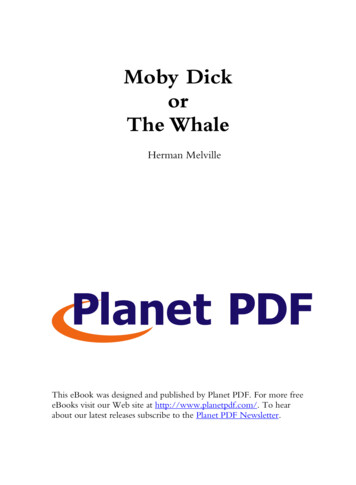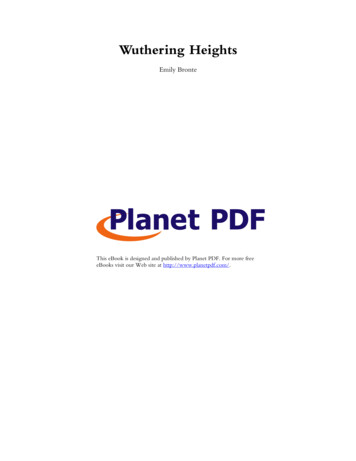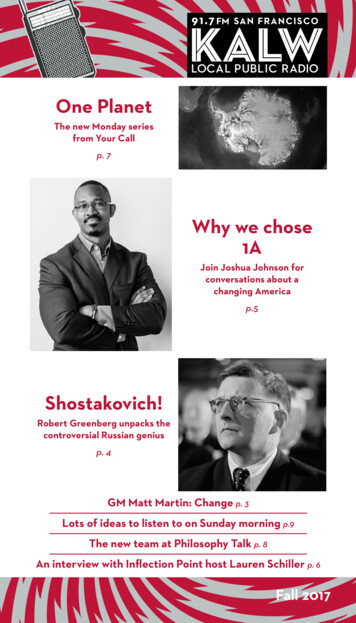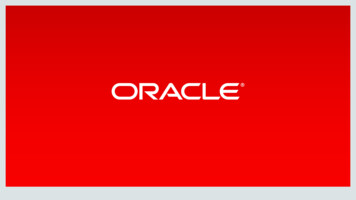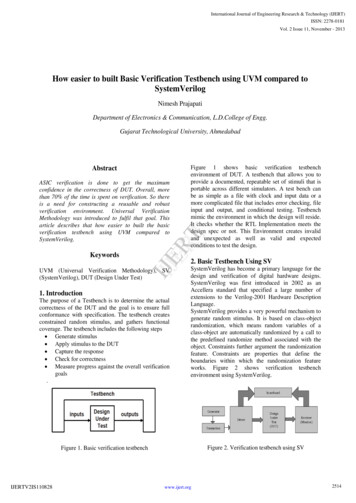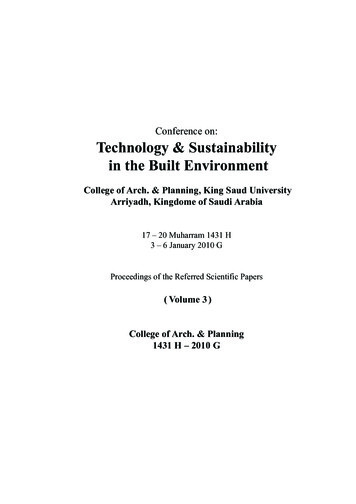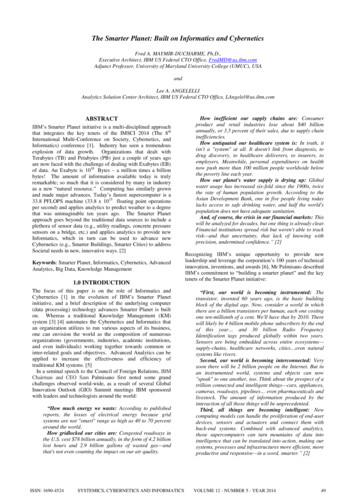
Transcription
The Smarter Planet: Built on Informatics and CyberneticsFred A. MAYMIR-DUCHARME, Ph.D.,Executive Architect, IBM US Federal CTO Office, FredMD@us.ibm.comAdjunct Professor, University of Maryland University College (UMUC), USAandLee A. ANGELELLIAnalytics Solution Center Architect, IBM US Federal CTO Office, LAngelel@us.ibm.comABSTRACTIBM’s Smarter Planet initiative is a multi-disciplined approachthat integrates the key tenets of the IMSCI 2014 (The 8 thInternational Multi-Conference on Society, Cybernetics, andInformatics) conference [1]. Industry has seen a tremendousexplosion of data growth. Organizations that dealt withTerabytes (TB) and Petabytes (PB) just a couple of years agoare now faced with the challenge of dealing with Exabytes (EB)of data. An Exabyte is 1018 Bytes – a million times a billionbytes! The amount of information available today is trulyremarkable; so much that it is considered by many in industryas a new “natural resource.” Computing has similarly grownand made major advances. Today’s fastest supercomputer is a33.8 PFLOPS machine (33.8 x 1015 floating point operationsper second) and applies analytics to predict weather to a degreethat was unimaginable ten years ago. The Smarter Planetapproach goes beyond the traditional data sources to include aplethora of sensor data (e.g., utility readings, concrete pressuresensors on a bridge, etc.) and applies analytics to provide newInformatics, which in turn can be used to advance newCybernetics (e.g., Smarter Buildings, Smarter Cities) to addressSocietal needs in new, innovative ways. [2]Keywords: Smarter Planet, Informatics, Cybernetics, AdvancedAnalytics, Big Data, Knowledge Management1.0 INTRODUCTIONThe focus of this paper is on the role of Informatics andCybernetics [1] in the evolution of IBM’s Smarter Planetinitiative, and a brief description of the underlying computer(data processing) technology advances Smarter Planet is builton. Whereas a traditional Knowledge Management (KM)system [3] [4] automates the Cybernetics and Informatics thatan organization utilizes to run various aspects of its business,one can envision the world as the composition of numerousorganizations (governments, industries, academic institutions,and even individuals) working together towards common orinter-related goals and objectives. Advanced Analytics can beapplied to increase the effectiveness and efficiency oftraditional KM systems. [5]In a seminal speech to the Council of Foreign Relations, IBMChairman and CEO Sam Palmisano first noted some grandchallenges observed world-wide, as a result of several GlobalInnovation Outlook (GIO) Summit meetings IBM sponsoredwith leaders and technologists around the world:“How much energy we waste: According to publishedreports, the losses of electrical energy because gridsystems are not "smart" range as high as 40 to 70 percentaround the world.How gridlocked our cities are: Congested roadways inthe U.S. cost 78 billion annually, in the form of 4.2 billionlost hours and 2.9 billion gallons of wasted gas—andthat's not even counting the impact on our air quality.ISSN: 1690-4524SYSTEMICS, CYBERNETICS AND INFORMATICSHow inefficient our supply chains are: Consumerproduct and retail industries lose about 40 billionannually, or 3.5 percent of their sales, due to supply chaininefficiencies.How antiquated our healthcare system is: In truth, itisn't a "system" at all. It doesn't link from diagnosis, todrug discovery, to healthcare deliverers, to insurers, toemployers. Meanwhile, personal expenditures on healthnow push more than 100 million people worldwide belowthe poverty line each year.How our planet's water supply is drying up: Globalwater usage has increased six-fold since the 1900s, twicethe rate of human population growth. According to theAsian Development Bank, one in five people living todaylacks access to safe drinking water, and half the world'spopulation does not have adequate sanitation.And, of course, the crisis in our financial markets: Thiswill be analyzed for decades, but one thing is already clear.Financial institutions spread risk but weren't able to trackrisk—and that uncertainty, that lack of knowing withprecision, undermined confidence.” [2]Recognizing IBM’s unique opportunity to provide newleadership and leverage the corporation’s 100 years of technicalinnovation, inventions, and awards [6], Mr Palmisano describedIBM’s commitment to “building a smarter planet” and the keytenets of the Smarter Planet initiative:“First, our world is becoming instrumented: Thetransistor, invented 60 years ago, is the basic buildingblock of the digital age. Now, consider a world in whichthere are a billion transistors per human, each one costingone ten-millionth of a cent. We'll have that by 2010. Therewill likely be 4 billion mobile phone subscribers by the endof this year and 30 billion Radio FrequencyIdentification tags produced globally within two years.Sensors are being embedded across entire ecosystems—supply-chains, healthcare networks, cities even naturalsystems like rivers.Second, our world is becoming interconnected: Verysoon there will be 2 billion people on the Internet. But inan instrumented world, systems and objects can now"speak" to one another, too. Think about the prospect of atrillion connected and intelligent things—cars, appliances,cameras, roadways, pipelines even pharmaceuticals andlivestock. The amount of information produced by theinteraction of all those things will be unprecedented.Third, all things are becoming intelligent: Newcomputing models can handle the proliferation of end-userdevices, sensors and actuators and connect them withback-end systems. Combined with advanced analytics,those supercomputers can turn mountains of data intointelligence that can be translated into action, making oursystems, processes and infrastructures more efficient, moreproductive and responsive—in a word, smarter.” [2]VOLUME 12 - NUMBER 5 - YEAR 201449
This paper describes the innovation and technologies behind theSmarter Planet imitative, which represents a state of the artapplication of Informatics and Cybernetics fundamentals.2.0 AUTONOMIC COMPUTINGEnterprise Systems Management (ESM) has evolved over thelast forty years, as the size and complexity of systems withinorganizations have grown. The administration and support ofthe many system elements (e.g., servers, storage and networks)becomes increasingly challenging as an organization transitionsto managing heterogeneous systems across their enterprise.Even today, the majority of our industry struggles to managesystem outages, configuration changes, performance tuning, andmany other ESM challenges. The Autonomic Computingvision emerged from decades of research and developmentfocused on increasing ESM automation and decreasing the needfor human intervention. The term “autonomic” is used toconnote the unprecedented level of automation the human bodyhas – i.e., our autonomic nervous systems, whichsubconsciously governs numerous, complex body functions.For example, our body autonomously measures oxygen levels,body temperature, blood sugar levels, etc. – and thenautomatically changes respiration, circulation and digestion todynamically address issues. One doesn’t think about increasingone’s breathing and circulation when climbing stairs; that’sdone autonomously by the body in order to control theanomalous exertion being forced on the body.2.1 TENETS OF AUTONOMIC COMPUTINGAutonomic Computing (AC) has four tenets: Self Configuring,Self Healing, Self Optimizing, and Self Protecting. [7]Figure 1: Autonomic Computing TenetsThese tenets, illustrated in the figure above, include thefollowing capabilities:Self Configuring – Many of today’s corporate data centershave a variety of components from a variety of vendors.Installing, configuring, and integrating components is timeconsuming and error-prone. The AC vision is to automate theconfiguration of components and systems according to highlevel policies; and the rest of the system adjusts automatically.Self Healing– Determining problems in large, complexsystems today can take a team of programmers and systemadministrators multiple weeks. The AC provides automateddetection, diagnosis and resolution to localized software andhardware problems.Self Optimizing – Today’s hardware and software containhundreds of measurements, diagnostics, alarms, and many moretuning options and parameters. The AC strategy is tocontinuously seek opportunities to improve performance andefficiency.Self Protecting – The majority of today’s mechanisms forprotecting and detecting system attacks and failures are silo’edand are slowly beginning to use standard security naming50SYSTEMICS, CYBERNETICS AND INFORMATICSconventions. The AC approach is to correlate the informationfrom many disparate protection and detection system elements,to automatically identify and defend against malicious attacksand cascading failures, to provide early warning, and to preventsystem-wide failures.2.2 AUTONOMIC COMPUTING ABSTRACTIONSA novel aspect of the AC vision is the goal of making decisionsthat take multiple perspectives into consideration. This can beaccomplished with contextual analytics, which provide views ofthe system elements from various levels of abstraction.Figure 2: Autonomic Computing Abstraction LevelsFigure 2 illustrates three different views of the same systemelements, but with a variety of relationships within differentcontexts. The lower level abstraction views system elements asa stand-alone entity, and only considers the type of element andvendor specific informatics when diagnosing problems andselecting corrective action. The middle level abstraction looksat the aggregation of similar elements (e.g., a pool of servers)and would extend the diagnostics and problem resolution toconsider things such as load balancing, disaster recoverypolicies, etc.The top level abstraction takes on a very different perspective.In this example, the top level abstraction places systemelements within the context of the corporate missions thesystem supports. One might place a higher priority on keepinglighter computing loads on mission critical system elements,rather than uniformly spreading computing loads across anenterprise-wide server farm.2.3 AUTONOMIC COMPUTING CYBERNETICSThe AC design is built on the premise that one must be able tomeasure, make a decision, and control system elements at all ofthe abstraction levels (as described in the example in Section2.2). This is called the AC control loop. Control loops aredesigned to provide the self-configuring, self-healing, selfoptimizing, and self-protecting capabilities.Figure 3: Autonomic Computing Control Loop ComponentVOLUME 12 - NUMBER 5 - YEAR 2014ISSN: 1690-4524
Figure 3 illustrates the composition of the AC control anisms that collect, aggregate and filter element data(measures) from sensors associated with the specific elementbeing controlled. The analyze sub-component is made up ofmechanisms that model or analyze complex situations withinthe scope of the control loop. The plan sub-component decidesthe actions needed to achieve the desired goals and objectives.(Note : Analyze and Plan are used to support the “decide” phaseof the AC control loop.) The decision logic has embedded “act,monitor and learn” functions, which verify the plan successfullysolved the problem or achieved the desired outcome. Theexecute sub-component executes the actions planned,supporting the control phase of the AC control loop. Theknowledge sub-component represents the KM associated withthe controlled element, and continuously grows as it stores theinformation that’s been measured, analyzed, planned, andexecuted – and the ensuing results.devices such as mobile phones and traffic cameras, or evenpassive micro-chips embedded in a pet or human being.The Smarter Planet cybernetics is built on three tenets:1.2.3.Instrumented: anything with a sensor can be anInformatics element. As previously described somesensors are uni-directional (they only provide data, orthey simply accept commands). The more usefulelements are bi-directional and do both!Interconnected: A smarter planet sensor must beinterconnected (preferably to the internet, or a hubcomputer w/ access to the internet), otherwise oneloses a tremendous amount of automation by havingto include a human in the loop (to read the data andenter it into the system). Some sensors need their datato be converted (e.g., analog to digital, or proprietaryrepresentations to industry standard representations).Intelligent: And a smarter planet solution is built onintelligent processing (Cybernetics) – exploitingadvanced analytics to optimize effectiveness andefficiencies from every possible perspectiveFigure 4: Autonomic Computing Hierarchical DesignNote that the AC control loop structure illustrated in Figure 3has sensors and effectors at the top and at the bottom. Thisdesign provides the ability to manage a single system entity, apool of entities, or the aggregation of multiple entities -- i.e., insupport of the various system levels of abstraction described inSection 2.2 and illustrated in the hierarchical figure above.It should be noted that AC is not a product. It is a vision thatcan be implemented at various levels of automation (e.g., selfhealing and self-protection), and support many system levelabstractions (e.g., resource pools or mission systems). AsInformation Technology (IT) matures, system elements haveimproved the information provided through “sensor” interfaces,and have increased the element commands that can be specifiedthrough “effector” interfaces to the system element.3.0 BUILDING A SMARTER PLANETThe authors contend that Autonomic, which focused onenterprise systems management and large data centers, was thetechnical predecessor to the Smarter Planet initiative. SmarterPlanet extends the scope of sensors well beyond the traditionalsystem elements (e.g., servers, storage, networks, etc.) andapplies advanced analytics to support a much broader set ofinformatics, inter-related abstractions (societal areas) andcybernetics. The authors recognize there were numerous othertechnical and non-technical advances that contributed to theevolving Smarter Planet campaign.Whereas Autonomic Computing acted on informatics providedfrom system elements, Smarter Planet’s cybernetics approach isto act on informatics from any type of data source – rangingfrom a utility meter or pressure sensor on a bridge, to mobileISSN: 1690-4524SYSTEMICS, CYBERNETICS AND INFORMATICSFigure 5: Intelligent Operations Center (IOC)The Intelligent Operations Center (IOC) is the framework thatenables the Smarter Planet to leverage different types of sensors(instrumented sensors and data sources), integrate the sensordata (provide interconnectivity), apply advanced analytics(intelligence) and then define and automate the smartercybernetics. Like the AC Control Loop Component, it supportsthe closed-loop cycle to the degree supported by the associatedsensor instrumentation.In the speech Palmisano gave at the Council on Foreign Relationsin New York City on November 6, 2008, he discussed IBM’sSmarter Planet vision – a new strategic agenda for progress andgrowth. Palmisano outlined the premise of a smarter planet and thecoming of age of a whole new generation of intelligent systems andtechnologies—more powerful and accessible than ever before.It provided a way for industries, infrastructures, processes, citiesand entire societies to be more productive, efficient, and responsive.Given the data explosion and computing advances of the previousmillennium, Palmisano believed there was an opportunity toaddress the problems and challenges that were gripping the worldduring 2008. A world capable of making more intelligentdecisions—from smarter power grids, to smarter food systems,smarter water, smarter buildings, smarter healthcare, and smartertraffic systems.Palmisano recognized that everything (including cars, powergrids, transportation, phones, etc.) was becoming moreinstrumented and interconnected. This technology phenomenonproduced more volumes, velocity, variety, and veracity (four Vs ofBig Data) of information and data being captured than ever before.VOLUME 12 - NUMBER 5 - YEAR 201451
By 2010, governments and industries were no longer questioningthe Smarter Planet vision nor values – they were looking forknowledge and experience on how to create Smarter Planetsolutions. Some of these are included in the figure below.availability, and life-cycle management. The portfolio ofbuilding assets is optimized through asset visibility andoperations management.[8]As shown in Figure 7 - the IBM Smarter Building solution wasbuilt and designed around the elements of visualization,intelligence, interconnected, instrumented, and physical. Thesesolution capabilities enable building managers to: integrate andoptimize the physical and digital infrastructure of buildings;create facilities that are more cost-effective, operationallyefficient, productive, safe, secure, and environmentallyresponsible; gather data, manage assets, monitor sensors,centralized analytics optimization; and distributed control.These Smarter Building solution capabilities will enable theintegration of a city’s buildings. When interactions between acity and buildings exist, the buildings can contribute to thehealth of the city. The city as a whole can reduce energyconsumption and carbon dioxide (CO2) emissions by 50–70%,energy usage reduced by up to 40%, maintenance cost 10-30%,and save 30–50% in water usage.Figure 6 – Smarter Planet Building BlocksOn January 12, 2010, Sam Palmisano kicked off the new year anddecade with a follow-up to the Smarter Planet speech with a newspeech called “The Decade of Smart” at the Chatham House inLondon, England which evolved the Smarter Planet initiative into amultiplatform strategy promoting the way in which IBMtechnology and know-how helps industry, government,transportation, energy, education, healthcare, cities, and otherbusinesses work smarter and contribute to building a smarter planet.Sections 3.1 and 3.2 describe the more mature “Smarter Buildings”and “Smarter Cities” solutions in more detail.3.1 SMARTER BUILDINGSIn the U.S., buildings consume 70% of all electricity, up to 50%of which is wasted. Commercial buildings lose as much as 50%of the water that flows into them. By 2025, buildings will be thesingle largest energy consumers and emitters of greenhousegasses on our planet. [8] In an attempt to reduced buildings’wasted resources – over the last decade, building owners haveinstalled smart sensors and control systems that can detect andsense various conditions and emit alerts or responses of manydisparate systems. These efforts have only lead to minimalcosts savings. The challenge for many building owners is howdo you collect the Big Data 4V’s from the silo information toprovide operational and performance improvements in thebuilding. This is a comprehensive effort because most of thebuilding systems (energy, heating, lighting, water, security andother specialized systems) operate independently, through a mixof vendors, and have different protocols and transportmechanisms.Building managers think and manage buildings along threedimensions: energy, operations, and space. They need to knowwhere are opportunities to save energy; identify operationaland/or capital improvements; and ability to optimize utilizationof buildings space. The IBM Smarter Building solution solvesthese building managers’ problems by addressing these keychallenges: energy and asset management, building operationsmanagement, and effective space utilization. The IBM SmarterBuilding solutions set has the following main areas:Energy management - energy management is the realtime monitoring of building and data center equipment. Itreduces energy consumption and waste over the life cycleof a building and increases facility performance in as
The Smarter Planet: Built on Informatics and Cybernetics Fred A. MAYMIR-DUCHARME, Ph.D., Executive Architect, IBM US Federal CTO Office, FredMD@us.ibm.com Adjunct Professor, University of Maryland University College (UMUC), USA and Lee A. ANGELELLI Analytics Solution Center Architect


